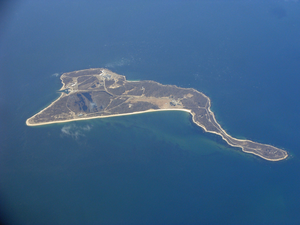Plum Island (New York)
| Plum Island | ||
|---|---|---|
| Aerial view of the island | ||
| Waters | Long Island Sound ( Atlantic Ocean ) | |
| Geographical location | 41 ° 10 '59 " N , 72 ° 11' 25" W | |
|
|
||
| length | 4.6 km | |
| width | 1.6 km | |
| surface | 3.4 km² | |
| Residents | uninhabited | |
| Aerial view of the Animal Disease Center | ||
Plum Island is an American island in the Atlantic . The island is the site of a high security research center for animal diseases and diseases. Administratively it belongs to the city of Southold in Suffolk County , New York . The island is located in Gardiners Bay , northeast of Long Island .
history
The first European to discover Plum Island was believed to be Adriaen Block , a Dutch navigator commissioned by the Dutch West India Company who mapped the region around 1614. The name of the island comes from the beach plums ( Prunus maritima ) that grow on the coast. In some older documents, however, the spelling “Plumb Island” can also be found.
In 1659, Samuel Willis , son of the then governor of Connecticut , acquired the island from a local Indian tribe. He paid the purchase price with a coat, a barrel of biscuits and 100 fish hooks.
On August 11, 1775, an American unit attacked British soldiers stationed on the island. The attack was repulsed, but it is considered the first example of an amphibious assault in US military history.
The island changed hands several times in the following decades. In 1899 the American government purchased the island for about $ 90,000. During the Spanish-American War, Fort Terry was built there, an important base for the control of shipping in Long Island Sound . The fort remained in readiness with interruptions until the Second World War . After the war it was temporarily deactivated and then handed over to the Chemical Corps of the US Army .
Research Center
In 1954, the United States Department of Agriculture established the Plum Island Animal Disease Center (PIADC) on the island , a high-security research center dedicated to the study and investigation of animal diseases. PIADC is currently the only laboratory in the United States that can conduct research on foot and mouth disease because research on live viruses of the disease is prohibited by law in mainland America . Research is also carried out on other animal diseases and epidemics, such as African swine fever , and diseases that can be transmitted from animals to humans, such as polio .
Also, there have been rumors and speculation about military research on the island for decades. The state has long denied that biological warfare experiments (see also: biological weapon ) were taking place on Plum Island . It was not until 1993 that Newsday was able to produce documents proving otherwise.
In 2003, this speculation was fueled when the United States Department of Homeland Security took over the island and research facilities; the Ministry of Agriculture is still present there with research activities. After the last reorganization, the facility belongs to the US Department of Homeland Security and the Office of National Laboratories (ONL) assigned there. In December 2008, a memorandum from the Department of Homeland Security recommended a new location in Kansas : A definitive decision is pending, but could mean the closure of the research center on Plum Island.
Access to the island and the research facilities are strictly limited. The island has its own fire brigade, its own power plant and its own sewage disposal. Wild mammals found on the island must be shot. On the other hand, the island is a bird paradise and some species are specially protected by appropriate facilities.
In popular culture
- The novel Plum Iceland by Nelson DeMille set partly on the island.
- In the film The Silence of the Lambs , Plum Island is suggested as a possible, monitored vacation spot for Hannibal Lecter in return for his support in the search for a serial killer. Lecter is not enthusiastic and mocks them as " anthrax island" (OT: Anthrax Island).
- The non-fiction author Michael Carroll dealt in his book Lab 257: The Disturbing Story of the Government's Secret Plum Island Germ Laboratory with the history of the research center and made the claim, among other things, that several epidemics started there: The West Nile Virus 1999, Lyme disease 1975, and duck plague 1967.


